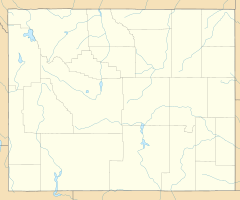Dale Creek Crossing
Dale Creek Crossing (48AB145) | |
 Original Dale Creek Wooden Bridge of 1868 | |
 Dale Creek Crossing | |
| Nearest city | Laramie, Wyoming |
|---|---|
| Coordinates | 41°6′15″N 105°27′17″W / 41.10417°N 105.45472°WCoordinates: 41°6′15″N 105°27′17″W / 41.10417°N 105.45472°W |
| Built | 1868 / 1876 |
| Architect | Union Pacific |
| NRHP reference No. | 86001027 |
| Added to NRHP | May 09, 1986[1] |

The 650-foot (200 m) Dale Creek Crossing, completed in 1868 in southeastern Wyoming Territory, presented engineers of the United States' first transcontinental railroad one of their most difficult challenges.[2] Dale Creek Bridge, the longest bridge on the Union Pacific Railroad (UP), reached 150 feet (46 m) above Dale Creek, two miles (3.2 km) west of Sherman, Wyoming.[3] The eastern approach to the bridge site, near the highest elevation on the UP, 8,247 feet (2,514 m) above sea level, required cutting through granite for nearly a mile. Solid rock also confronted workers on the west side of the bridge where they made a cut one mile (1.6 km) in length.[4]
Originally built of wood, the trestle swayed in the wind as the first train crossed on April 23, 1868.[5] In the days following, as carpenters rushed to shore up the bridge, two fell to their deaths. Still, the bridge's timbers flexed under the strain of passing trains.[citation needed]

The original bridge was replaced on the 1868 piers in 1876 by an iron bridge, manufactured by the American Bridge Company. The wooden approaches at each end remained in place when the iron bridge was built. The western approach caught fire in 1884, and was repaired. The UP installed girder spans and granite abutments to strengthen the bridge in 1885.[5] Engineers installed guy wires on both the wooden bridge and its iron replacement in an attempt to stabilize the structures.
"Standing on its tall, spindly iron legs that looked as sturdy as knitting needles, it was the highest and most dangerous crossing on the line. Engineers had to slow the train to 4 mph (6 km/h), or a stiff Wyoming wind would push empty boxcars into the rocky gap."[6]
The replacement iron "spider web" bridge, in turn, was dismantled in 1901,[5] when the Union Pacific completed construction of a new alignment over Sherman Hill[7] as part of a major reconstruction and improvement project, shortening the Overland Route by 30.47 miles (49 km).
References[]
- ^ "National Register Information System". National Register of Historic Places. National Park Service. April 15, 2008.
- ^ Pride and pitfalls along a coast to coast track, by Michael Kenney. Boston Globe. January 10, 2000. A book review: Empire Express: Building the first transcontinental Railroad, by David Haward Bain.
- ^ "Construction". Historical Overview. Omaha, Nebraska: Union Pacific Railroad. Archived from the original on 2012-04-08. Retrieved 2014-04-05.
- ^ Ambrose, Stephen E (2001). Nothing like it in the world: the men who built the transcontinental railroad, 1863-1869. Simon and Schuster. ISBN 978-0-7432-0317-3.
- ^ Jump up to: a b c Gardner, Mark L. (1988). "Dale Creek Crossing". Annals of Wyoming. Wyoming State Press. 60 (1): 3–5.
- ^ Rogstad, Jodi (2006-11-19). "Pyramid on the prairie". Wyoming Tribune Eagle. Cheyenne, Wyoming. Retrieved 2019-01-12.
- ^ "The Rebuilt Union Pacific". The Railway Age. Chicago. 32 (6): 108. 1901-08-09.
External links[]
| Wikimedia Commons has media related to Dale Creek Crossing. |
- Dale Creek Crossing at the Wyoming State Historic Preservation Office
- "Dale Creek Crossing". National Register of Historic Places. Cheyenne, Wyoming: Wyoming State Historic Preservation Office. Retrieved 2020-05-18.
- Railroad bridges on the National Register of Historic Places in Wyoming
- Buildings and structures in Albany County, Wyoming
- Bridges completed in 1868
- Transportation in Albany County, Wyoming
- Railroad bridges in Wyoming
- Union Pacific Railroad bridges
- National Register of Historic Places in Albany County, Wyoming
- Trestle bridges in the United States
- Wooden bridges in the United States
- Iron bridges in the United States

